Andy Paul's Blog, page 2
July 29, 2022
Do sales managers get in the way?
Timid sellers produce timid results.
That’s on sales bosses.
Warning: I’m going to use a sports analogy.
While I’m generally leery of comparing selling to sports. I make an exception for soccer.
The fluidity and ambiguity for how the game unfolds is a lot like working a sales opportunity.
I also believe that professional soccer is light years ahead of professional selling in how the players are developed, coached and managed. (Don’t get me started about how much more advanced soccer clubs are in their use of data compared to sales organizations…)
Jesse Marsch is the first American to coach a soccer team in the UEFA Champions League, the premier club competition in the world.
He was the head coach of Red Bull Salzburg, the top team in Austria, and Red Bull Leipzig in the German Bundesliga. Now he’s the head coach at Leeds United in the English Premier League.
He’s a master motivator and incredibly thoughtful about how to develop the capabilities of his players.
Read the following quote of his:
“Game day is for the players — I actually think coaches get in the way. There are occasions when unexpected things happen in a match and a coach has to manage that situation effectively. But, I want my players to go out there and feel free. If they’re constantly feeling judged then it’s a block for them to make mistakes and learn from them.”
Let me translate that into sales-speak:
“Selling is for the sellers – I actually think managers get in the way. There are occasions when unexpected things happen in a sales situation and a manager has to manage that situation effectively. But I want my sellers to go out there and feel free. If they’re constantly feeling judged then it’s a block for them to make mistakes and learn from them.”
If your sellers constantly feel that pressure of being judged or measured, then too few will experiment and risk making a mistake.
This is exactly what you don’t want to happen. Timid sellers produce timid results.
Mistakes are an essential learning path for sellers. You have to feel confident enough in yourself as a manager to let those mistakes happen.
It’s possible to build a culture of accountability in sales without every seller feeling that there’s a sword hanging over their head.
The best way to do that is to establish clear expectations for your sellers. Then get out of their way. Give them the freedom, and the responsibility, to make mistakes and learn from them.

The post Do sales managers get in the way? appeared first on Andy Paul.
July 20, 2022
Is your connection with your buyer hanging by a thread?
2 is better than 1
Don’t single thread it when you connect with a buyer.
In this instance, I mean building a human connection with an individual stakeholder (not the collective buyer.)
Would you build an account strategy for a major opportunity based on a single-threaded point of contact? Of course you wouldn’t.
The same lesson applies to building relationships with key stakeholders in the buyer’s DMU. (btw is there a more superfluous acronym in sales??)
Research finds that humans put more trust in relationships where there is more than one basis for connecting.
Sociologists call these “multiplex ties.”
The strongest connections you can build with your individual buyers will be based on a combination of personal and business touch points.
In other words, the strongest connections are based on finding multiple areas of common ground.
So, if you’re been coached that buyers have “no time for small talk” that’s just wrongheaded.
When you’re taught that you have to keep the conversation “all business,” that’s super wrong too.
The combination of personal and business ties is stronger than just business alone.
How do you build multiplex ties with buyers? The same way you would with any person in your life
Start by being more interested in them than you are in yourself.
Then, it sounds almost silly at this point to have to mention this, but before you meet with a stakeholder at a new account, do your research. Do your preparation. Use LinkedIn. Social. Google. TikTok.
What can you learn about this person, from a personal context, that will help you establish a stronger connection?
Are there areas where your interests overlap?
Family?
Travel?
Hobbies?
Charity?
Sports team?
Side-hustle?
Books?
School?
People you follow?
Then create some simple open-ended questions that spark some conversation about any one of those topics where you have an interest too.
It’s the multiplex ties that bind.

The post Is your connection with your buyer hanging by a thread? appeared first on Andy Paul.
June 30, 2022
Objections Aren’t the Problem, You Are
Don’t “handle” objections.
Answer them.
Here’s the thing: words matter. Words dictate our actions.
What happens when a buyer “objects” to your pricing? You get defensive
What happens when you try to “handle” an objection? You become adversarial.
The whole idea of “handling” an objection is that you come up with a work around without addressing the core concern of the buyer. In other words, you get a bit manipulative. Salesy.
And your buyers feel that.
Do this instead.
First of all, you need to understand that your buyers aren’t objecting to your pricing. Or, whatever you think they are objecting to.
They don’t care enough to object. “Your Honor, I object to this pricing!” Seriously, they don’t care that much.
What buyers actually are saying is that they don’t understand something.
Like the rationale behind your pricing. Or they don’t understand the value and payback they’ll receive from investing in your products. They don’t understand why it makes business sense for them.
In other words, their “objection” is just a question.
That’s all an objection is. A question.
And buyers need you to answer it. Not deflect it. Or obfuscate. Or detour around it.
Where an “objection” is adversarial, a question is cooperative.
You work with the buyer to understand and answer their question.
So, don’t get all defensive and try to “handle” an objection. Or “manage” the objection.
It smacks of manipulation. And your buyers feel it.
Instead ask your own question(s) to precisely define what the question is that the buyer needs you to answer. Then answer it.
It’s pretty simple.

The post Objections Aren’t the Problem, You Are appeared first on Andy Paul.
May 18, 2022
Every Sales Interaction with a Buyer is the Most Important One
The Peak-End Rule of Sales will transform how you visualize your selling process.
In sales, we increasingly acknowledge the importance of the buying experience as a key factor in a buyer’s decision about which seller to choose.
Daniel Kahneman, the Nobel Prize winning economist, developed the Peak-End Rule based on his research into how people factor the quality of an experience into their decision-making.
Barry Schwarz, in his book, The Paradox of Choice, succinctly summed up the Peak-End Rule:“Kahneman showed that what we remember about the quality of our past experiences, both good and bad, was almost entirely determined by how the experiences felt when they were at their peak (best or worst) and how they felt when they ended. We use the peak-end rule to summarize the experience and to remind ourselves how the experience felt.”
In sales terms, think about what the Peak-End rule means. It means that when your customers arrive at the conclusion of their buying journey, and are evaluating their buying experiences with the various sellers competing for their business, their decisions about you (your product and your company) will be heavily influenced by two factors:
1. The peak experience, either good or bad, they had with you during their buying journey.
2. How they felt after their last interaction with you.
The Peak-End Rule is consistent with everything we know about buyers in today’s business environment. They are extremely busy and short on time. They are pressed to make better decisions faster.
When the time arrives to make their decision your buyers will consider all the factors, both tangible and intangible, that might distinguish you and your offering from those of your competitors.
That includes evaluating their peak buying experience from how you sold to them and their last interaction with you. And, they’ll use those peak events as key criteria in their decision whether to give you their business.
The Peak-End Rule of Sales means that you have the imperative to create peak buying experiences that make your selling valuable and memorable to the buyer.
As a result, you have to act with intention. Which means planning and executing each sales action as if it will be the peak buying experience. It means that you have to provide value in every interaction that helps the buyer make progress toward making a decision.
It would be really useful if you could predict in advance which sales touch among the many in your selling process will be experienced as the peak event from the perspective of your buyer. However, you can’t.
This means you have to bring your “A game” every time you interact with your buyers. Any sales interaction, no matter how big or small, holds the potential to be the peak event for your buyer.
This is especially critical if the product you’re selling is perceived by buyers to be similar to those of your competitors. Then you need to focus on how to create peak buying experiences in every sales interaction that will differentiate you from the herd.

The post Every Sales Interaction with a Buyer is the Most Important One appeared first on Andy Paul.
March 31, 2022
Why Sellers Need to be Interested and Interesting
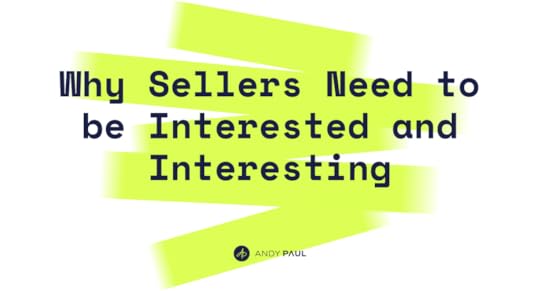
Sellers need to be interested and interesting.
Here’s what I mean…
Pretend you’re a buyer who receives calls from 2 sellers.
One makes a pitch for his product. The other seller asks relevant questions about you, your challenges, and your goals.
Which one would you reward with your attention?
Let’s take that one step further….
Do you know how to make a friend?
I hesitate to use the word friend in this context because you are not trying to become friends with your buyers.
Friendly, yes. Friends, no.
However, research shows the key to successfully connecting with a person you’ve just met is knowing how to make a friend.
Yep. That’s it. Make a friend.
So, visualize yourself in a social setting.
You were just introduced to someone at a party. A friend of a friend.
What do you say to them?
Do you immediately ask them to give you something?
Of course not.
When you meet someone new in a purely social setting, you don’t think only of what that person can do for you.
You show a genuine interest in that person and try to establish a bond based on a common interest.
And that’s all you need to do when you’re connecting with a buyer.
The next time you speak with a potential buyer for the first time, imagine instead that you’re meeting them at a party, at your kid’s school, or in some non-business setting.
In that environment, ask yourself, what’s the first question I’d normally ask a new acquaintance?
Connecting is simple.
Be more interested in others than in yourself.
Be more interesting than your competition.

The post Why Sellers Need to be Interested and Interesting appeared first on Andy Paul.
March 25, 2022
What Do Buyers Need From You?
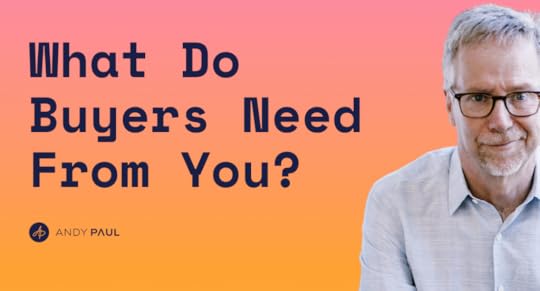
Sales is a human business.
So, I really hate to say this, but…
Sellers aren’t very good at selling to humans.
More often than not, your customers make the decision to buy from you in spite of you, not because of you. If you’re going to stop Selling Out, you have to take control of how you sell.
Before you can do that, you first have to understand exactly what your buyers need from you.
According to a Forrester study, executives consider less than one fifth of the meetings they have with salespeople to be valuable. In other words, more than 80% of buyers earned zero return on the time and attention they invested in you.
Buyers are figuratively holding their noses and buying from you in spite of your best efforts to sell to them. This happens primarily because you have been Selling Out.
Look at selling this way: every choice and decision a buyer makes during their buying journey is their referendum on you. And it’s personal. Not in a “you’re a bad human” sort of a way.
Personal as in “you don’t really understand what’s most important to me, so I don’t have confidence that you can help me get it.”
When your buyers set out to explore the purchase of a new product or service, what is their mindset?
Do they want to invest unlimited amounts of time and effort to exhaustively investigate all their alternatives?
I mean, if they’ve recognized that they have a problem to solve, or a pain point to cure, do they dismiss the urgency and give themselves as much time as they need to make the optimal decision?
No.
So, when a buyer is ready to have a conversation with you, when a buyer is prepared to invest their time and attention in you, it’s because they need your help. They’ve gone as far as they can go on their own, and now they’ve turned to you.
Your job as a seller is to listen to understand what the most important thing is to your buyer. And then help them get it.
Your buyers need your help with that second part; the “help them get it” part.
At that moment your buyer needs your help to:
(1) Quickly gather and make sense of the information they need to make a decision about how to get their most important thing; and,
(2) Accomplish this with the least possible investment of their time, attention, and resources.
But here’s the thing. Selling Out doesn’t get them there. Buyers don’t need your process. They don’t need a dose of your earnest persuasion. They don’t need you to be salesy. They’ll go through their buyer’s journey without you if you add friction to their process and force them to invest more time and attention than necessary.
If you start Selling In, every sales action you take will align with this goal of your buyers. They need your influence to help them make the right choices and decisions. Start Selling In and you’ll become the reason your buyers decide to buy from your company. Not your product. Not your company. You.
The post What Do Buyers Need From You? appeared first on Andy Paul.
March 10, 2022
Are you a Sales Leader or a Sales Boss?
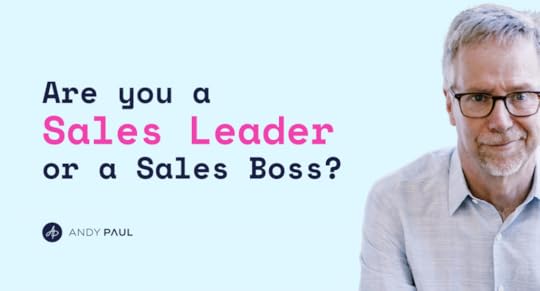
As a sales manager, you have a singularly tough job, for which you’ve received minimal training and support. I get it. I’ve been there myself.
However…
You have to make a choice.
What type of manager do you want to be?
You can be a sales leader.
Or you can be a sales boss.
You can’t be both.
What are the Differences Between the Two?Well, let’s start with the basics.
Sales leaders know their success flows from helping their people become the best version of themselves.Sales bosses think success is based on driving their people to do more stuff.
Being merely a sales boss isn’t helping your sellers. And it certainly isn’t helping you achieve the things in your career that are most important to you.
It’s time for a change.
No one is better positioned to help your sellers stop Selling Out and start Selling In than you.
There will be challenges. For instance, if you’re a sales boss, chances are that you work for a sales boss too. So, some of this behavior is probably being forced on you.
Again, I get it. But to be the solution, you need the courage to change.
 Your Ambition
Your AmbitionAs someone who is responsible for the performance and growth of your sellers, your ambition should never be to make all of your sellers into clones of your “top performer.” It won’t work. It’s counterproductive.
Every seller is unique in their mental makeup, mindset, and capabilities, which means that their recipe for personal success is unique to them. You shouldn’t try to fit a square peg into the round hole that is your one-size-fits-all sales process.
As a sales leader, you should aspire to help every one of your sellers become the very best version of themselves.
This is what they want.
This is what you should want.
This is the express ticket to faster growth through improved sales performance.
And to a team of sellers that are more productive, less stressed, more fulfilled, and prepared to stick around and grow with you.
Also, if you read my book or hear my podcast, you’ll hear me tell sellers that they need to push back on orders and suggestions from you that aren’t helping them develop and grow.
If they want to become the best sales version of themselves, they need to be given the autonomy to experiment and fail on their own terms.
That may make you nervous because you believe that the certainty of your sales process is what enables individual sales success. Don’t kid yourself; it doesn’t.
Don’t get me wrong. Process is important. But your process works only to the degree that it supports the personal sales process of the individual seller. Sell Without Selling Out gives sellers the right tools and mindset to develop a successful process of selling that is in alignment with their strengths and with what their buyers need from them to make good decisions. That’s how they become the very best version of themselves.
If you support that, it’s a win for your buyers, your sellers, and you.
And you’ll find yourself evolving from a sales boss into a sales leader.

The post Are you a Sales Leader or a Sales Boss? appeared first on Andy Paul.
February 26, 2022
Influence Rules, Persuasion Drools
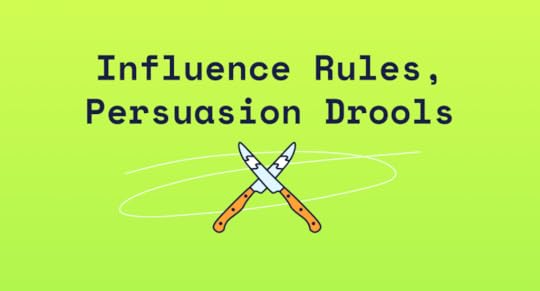
This article is part of the Sell Without Selling Out series, where I publish learnings based on my human-first approach to sales. Order your copy of my new book Sell Without Selling Out (now a #1 new release on Amazon) today and claim awesome free bonuses (like my action workbook).
They Are Not The SameDespite the best efforts of various sales experts and sales trainers to conflate and interchangeably use the words influence and persuasion, they are not the same thing.
There’s a reason Dale Carnegie didn’t title his classic book How to Win Friends and Persuade People.
To persuade means to prevail on someone to do something by argument, entreaty, or expostulation. To prevail is to gain ascendancy by strength. In other words, to coerce a buyer to do something, which just reinforces their negative image of sellers as sellouts.
If your primary job in sales is to listen to understand what the most important thing is for your buyer, and then help them get that, then what value does persuasion offer?
Are you going to persuade the buyer to change their mind about what is most important to them?
Similarly, if your buyer’s job is to quickly gather and make sense of the information they need to make a decision to get what is most important to them, then how does persuasion help them achieve that?
Your buyers want you to be a source of value that helps them make informed trade-offs and decisions about how to achieve their most important thing. Which means that your persuasive coercion is of no value to your buyer.
Persuasion Is Not A Sales SkillPersuasion is not a sales skill. It’s a blunt instrument of last resort that sellers use when they don’t understand how to influence the choices their buyers make. In that sense, influence is the antithesis of persuasion in sales.
Influence is defined as the mental and emotional aptitude to change the actions, understanding, and behavior of other people without the apparent exertion of force.
In other words, we use the 4 Pillars of Selling In, our our Connection, Curiosity, Understanding, and Generosity, to influence the actions, understanding, and behavior of the buyer.
Sellers who believe that their job is to persuade buyers to purchase their products or services are selling drills (i.e. products.).
Sellers who help their buyers identify the problems they need to solve and define their options for achieving their desired outcomes are selling holes (i.e. outcomes.).
 Influence Mindset
Influence MindsetHaving an influence mindset rather than a persuasion mindset alters the nature of how you interact with a buyer.
Influence has a positive impact on the experience your buyer has with you. (In contrast to the universal human resistance to being pushed, prodded, and persuaded.)
Here’s a simple way to think about the difference between persuasion and influence: If you’re a persuasion-based seller, you believe your job is to change the minds of your buyers to buy your product.
If you’re an influence-based seller, you believe your job is to first understand your buyers and then help them make up their minds about how to solve their problem and achieve their desired outcomes.
Persuasion as practiced by most sellers is a zero-sum game. If you’re trying to persuade your buyer to change their mind, you are telling them, in essence, “I know better than you. I’m right. And you’re wrong.” That’s Selling Out. Which is not exactly a productive way to strengthen your connection with the buyer.
Contrast that with the buyer’s experience with Selling In. The person Selling In doesn’t operate on assumptions. Instead, they focus on making the buyer feel heard and understood before recommending a solution.

About the Author
Andy Paul is a bestselling author, sales leader, speaker, and global sales advisor focused on human-first selling. Through his bestselling books and industry-leading sales podcasts, he has reached millions of sellers who know that process, methodology and technology don’t win deals; people do. Andy’s latest book, Sell Without Selling Out, is on sale at Amazon now.
©Andy Paul 2022.
The post Influence Rules, Persuasion Drools appeared first on Andy Paul.
February 23, 2022
My Book is Out Today! Here’s Why I Wrote It
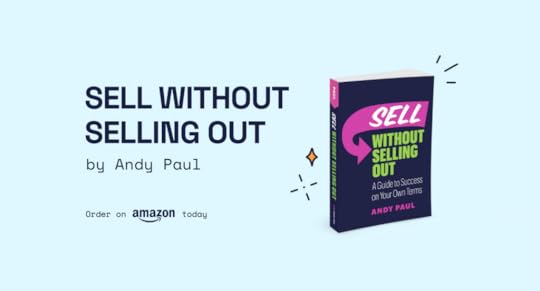
Sell Without Selling Out is now available for purchase, reading (or listening if you prefer) and reviewing! It’s my road-tested framework for rejecting the outdated salesy behaviors that buyers hate and seizing control of how you sell.
This book has been 2.5 years in the making.
I had most of a draft manuscript written prior to the start of the pandemic.
Then with all the craziness and confusion going on at that time I lost focus and momentum.
The writing came to a grinding halt.
However, as Winston Churchill once said “Never let a good crisis go to waste”.
A Crisis WastedUnfortunately, in sales, we’ve done just that.
As we’ve worked our way through the pandemic we had the perfect opportunity to reinvent selling.
We had the opportunity to take advantage of the disruption in our normal ways of doing business to fundamentally reshape how we interact and work with our buyers to help them make their decisions.
Instead, we’ve let the moment pass us by.
Because instead of embracing needed change we have doubled down on the salesy behaviors that repel buyers. We act as if these salesy actions are somehow less cringe-inducing if they’re performed digitally vs in-person. (Hint: they’re not.)
We have to take a hard look in the mirror and ask ourselves, how long are we willing to maintain the status quo when:80% of decision makers state they find no value in their interactions with sellers
 Only 3% of people trust salespeople
Only 3% of people trust salespeople
 Fewer than 50% of sellers hit their quotas
Fewer than 50% of sellers hit their quotas
 Close rates and win rates are dropping
Close rates and win rates are dropping
 Increasing percentages of buyers state that they’d prefer not to deal with salespeople
Increasing percentages of buyers state that they’d prefer not to deal with salespeople
For me, enough was enough. The profession I loved was in danger of burning to the ground and something had to be said.
And, that lit the fuse that drove me to finish this book.
 It’s Time to Take Back Sales
It’s Time to Take Back SalesI believe that everyone can make the decision to stop these salesy behaviors today.
Every seller can easily go cold turkey and just kick the habit. Today.
These salesy behaviors have no value for the buyer. And, if they have no value for the buyer, they have no value for you. So, just stop. Today.
The sellers who will most successfully adapt and thrive in an increasingly digital future are those who learn how to differentiate themselves by amplifying their most uniquely human attributes:
 To connect and collaborate with other humans
To connect and collaborate with other humans
 To deploy their curiosity to navigate the new and unfamiliar
To deploy their curiosity to navigate the new and unfamiliar
 To move beyond knowing to truly understanding what is important to others
To move beyond knowing to truly understanding what is important to others
 To generously give to help others get what is most important to them
To generously give to help others get what is most important to them
In Sell Without Selling Out I’ve created the playbook for those truly modern sellers.
It’s for sellers who understand that selling is not something you do TO a buyer. It’s a collaborative process you do with a buyer.
It’s for sellers who want to work with their buyers to create the kind of positive buying experiences that lead to shorter decision cycles and higher win rates.
It’s for the sellers who are choosing to abandon the obsolete salesy behaviors that repel their buyers.
In short, it’s for you.
Death to Salesy!
Andy
#deathtosalesy #takebacksales
P.S. I’ll be releasing a series of excerpts over the next few weeks. Subscribe to this newsletter to be notified when they go live.
P.P.S. Ready to equip your team with a human-centered approach to sales? For a limited time, sales leaders can book a complimentary strategy session with me! Talk about your organization’s goals and learn more about bulk order discounts for your team. Click here to reserve your spot.

The post My Book is Out Today! Here’s Why I Wrote It appeared first on Andy Paul.
February 15, 2022
Winning is a Habit
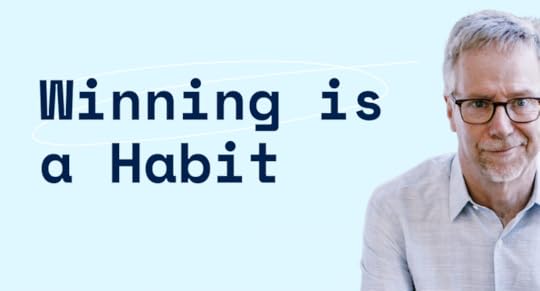
This article is part of the Sell Without Selling Out series, where I publish learnings based on my human-first approach to sales. Grab your copy of my new book Sell Without Selling Out (shipping 2-22-22) today and claim awesome free bonuses (like my implementation playbook).
Early in my sales career I came across a Vince Lombardi quote.
It really resonated with me at the time.
And it still does.
Why?
Because I’d graduated from college with no discernible job skills.
So, naturally, I went into sales.
And I was struggling to define who I was as a seller and how that related to who I was as a person.
Those two have to be in sync if you want to win consistently.
I forget where I first saw this particular Lombardi quote.
It’s nominally about winning.
In truth, it’s about much more.
Winning is a habit. Watch your thoughts, they become your beliefs. Watch your beliefs, they become your words. Watch your words, they become your actions. Watch your actions, they become your habits. Watch your habits, they become your character.
You are the sum of your thoughts and beliefs as they are translated into action by your habits.
That’s your character.
It’s defined by what you routinely do on a daily basis.
It’s become a cliche in sales to say that people buy from sellers that they know, like and trust.
However, sales is a people business.
And your character is the first thing that another person first perceives about you.
 Character Precedes Trust. And Knowing. And Liking.
Character Precedes Trust. And Knowing. And Liking.The ability to connect on a personal level with another human is paramount to your success in sales. This connection is all about character.
Want to know how important character is in sales?
Ask yourself the following questions:
How often do you invest your time in getting to know someone whose character you don’t respect?How often do you like someone whose character you don’t respect?How often do you trust someone whose character you don’t respect?Will a buyer purchase from a seller whose character they don’t respect?
Sure, anything is possible.
However, it’s just not very probable.
This is newsletter #2 of a 3 part series on Character in Sales.
Next week I’ll be giving you 4 Interview Questions to Learn About a Seller’s Character.
Good Selling,
Andy
P.S. My new book Sell Without Selling Out is released one week from today (2/22/22). This is not another work of sales fiction. A story about morphing overnight into a sales superstar. There’s none of that BS here. Want to experience the energy, impact, and fulfillment that come from being the best version of yourself in any sales situation?
Grab your copy today and DM me for access to some awesome free bonuses.
[image error]The post Winning is a Habit appeared first on Andy Paul.
Andy Paul's Blog
- Andy Paul's profile
- 4 followers



